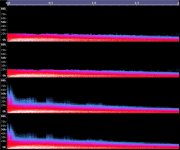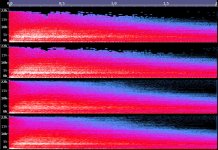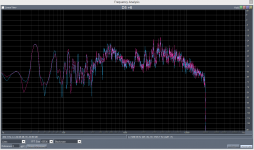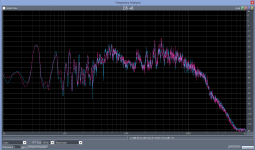Even knowing which is filtered from Audacity analysis, I cannot hear any difference.
The original samples are interesting for containing significant power above 20 KHz
It would be interesting to repeat the test at 32ksps
The original samples are interesting for containing significant power above 20 KHz
It would be interesting to repeat the test at 32ksps
We are already past ten poll votes, but am thinking letting it go a bit longer, so please continue voting and it's anonymous, even I can't see who have taken part.
And attached below a snapshot of present poll stat.

And attached below a snapshot of present poll stat.
You are the Hitchcock of the polls.We are already past ten poll votes, but am thinking letting it go a bit longer
Ok, the listening test have run its course, although one can still continue take part, but for the moment the snapshot of the poll votes is as depicted in first Pic 1 attachment.
Pic 2:
Spectrogram comparison of resampled/encoded file A1 (upper) VS original cymbal file A2 (lower).
Pic 3:
Spectrogram comparison of resampled/encoded file A1 (upper) VS original cymbal file down sampled to 16 bit 44.1 kHz (lower), this wasn't part of the listening test files so is only shown here for comparison between MP3/44 VS 16/44 WAV.
And the decryption key is: gotbassforbatears
Take the encrypted text in post #2 and head over to AES encryption
set the en-/decryption to 256 bit and the output should look like as follow (I just tested it OK):
Finally, attached are the 3 cymbal samples from the intermediate step where the original file was down-sampled/re-encoded to MP3 320kbs, which in this listening test was again up-sampled and re-encoded to have the same appearance file-wise as the original files, some may have had a peek at the spectrogram and figured out something.
Due to limitation of the forum the file extension is changed from .mp3 to .mp4, some media players will replay them right off, otherwise please rename the file extensions back to.mp3.
Thank you everyone for taking part in this listening test session, happy new diy year.
Michael
ps. The file size of the attached MP3 files is reported in my Linux machine as 82,5 kB although this forum shows 80,6 kB
Pic 2:
Spectrogram comparison of resampled/encoded file A1 (upper) VS original cymbal file A2 (lower).
Pic 3:
Spectrogram comparison of resampled/encoded file A1 (upper) VS original cymbal file down sampled to 16 bit 44.1 kHz (lower), this wasn't part of the listening test files so is only shown here for comparison between MP3/44 VS 16/44 WAV.
And the decryption key is: gotbassforbatears
Take the encrypted text in post #2 and head over to AES encryption
set the en-/decryption to 256 bit and the output should look like as follow (I just tested it OK):
The original file is ca 2.1MB.
The intermediate downsampling step to 320kbs/44.1kHz MP3 shrank the file size to ca 82.5kB, and after the upsampling the size was back to ca 2.1MB.
A1 = zildjian-18-inch-k-custom-dark-crash.wav (RESAMPLED)
A2 = zildjian-18-inch-k-custom-dark-crash.wav (ORIGINAL)
B1 = zildjian-22-inch-a-custom-ping-ride-ping.wav (RESAMPLED)
B2 = zildjian-22-inch-a-custom-ping-ride-ping.wav (ORIGINAL)
C1 = paiste-18-inch-2002-medium-crash.wav (RESAMPLED)
C2 = paiste-18-inch-2002-medium-crash.wav (ORIGINAL)
The above 3 samples can also be find under the following URL's:
https://www.hometheaterhifi.com/ima...jian/zildjian-18-inch-k-custom-dark-crash.wav
https://www.hometheaterhifi.com/ima.../zildjian-22-inch-a-custom-ping-ride-ping.wav
https://www.hometheaterhifi.com/ima...s/Paiste/paiste-18-inch-2002-medium-crash.wav
Finally, attached are the 3 cymbal samples from the intermediate step where the original file was down-sampled/re-encoded to MP3 320kbs, which in this listening test was again up-sampled and re-encoded to have the same appearance file-wise as the original files, some may have had a peek at the spectrogram and figured out something.
Due to limitation of the forum the file extension is changed from .mp3 to .mp4, some media players will replay them right off, otherwise please rename the file extensions back to.mp3.
Thank you everyone for taking part in this listening test session, happy new diy year.
Michael
ps. The file size of the attached MP3 files is reported in my Linux machine as 82,5 kB although this forum shows 80,6 kB
Attachments
-
 poll votes screenshot 2020-January-10.png26.6 KB · Views: 108
poll votes screenshot 2020-January-10.png26.6 KB · Views: 108 -
 Sample comparison of pair A1-upper vs A2-lower.jpg114.2 KB · Views: 142
Sample comparison of pair A1-upper vs A2-lower.jpg114.2 KB · Views: 142 -
 Comparison A1-upper vs A1_16-44-lower.jpg235.8 KB · Views: 122
Comparison A1-upper vs A1_16-44-lower.jpg235.8 KB · Views: 122 -
A1 - zildjian-18-inch-k-custom-dark-crash.mp480.6 KB
-
B1 - zildjian-22-inch-a-custom-ping-ride-ping.mp480.6 KB
-
C1 - paiste-18-inch-2002-medium-crash.mp480.6 KB
Last edited:
Hi UT,
sorry I am coming late, I think I can hear difference between A1 and A2 and here is my ABX. I did not try other samples.
sorry I am coming late, I think I can hear difference between A1 and A2 and here is my ABX. I did not try other samples.
Code:
foo_abx 2.0.2 report
foobar2000 v1.4.8
2020-01-11 09:45:22
File A: A1.wav
SHA1: 0259aa4b0bbbcc86942433499f830ab30cbf9ae4
File B: A2.wav
SHA1: b9bf6f75526deee8f443fd421c3eeb0417bf2c3b
Used DSPs:
Resampler (PPHS)
Output:
ASIO : Creative Sound Blaster ASIO
Crossfading: NO
09:45:22 : Test started.
09:45:42 : 01/01
09:45:49 : 02/02
09:45:56 : 03/03
09:46:03 : 04/04
09:46:10 : 05/05
09:46:17 : 06/06
09:46:23 : 07/07
09:46:29 : 08/08
09:46:35 : 08/09
09:46:41 : 09/10
09:46:41 : Test finished.
----------
Total: 9/10
Probability that you were guessing: 1.1%
-- signature --
3e7905410faaa98110784f1e2100b3edf156916dPic 2:
Spectrogram comparison of resampled/encoded file A1 (upper) VS original cymbal file A2 (lower).
I got this, from the first part of the samples A1,2. A1 is the truncated. I made the analysis after listening test, and the correlation is perfect, A2 is the one that sounded sharper with subjectively higher pitch.
Attachments
Hi Pavel and thanks for your contribution, well appreciated and interesting, I like the idea of subtraction A1-A2.
I have to point out that while doing the re-encoding the original file to mp3 that audacity did for some reason add some 350 ms blank before the cymbal attack (see my previous post where the mp3 files are attached), so after once again re-encoding the mp3 file back to 24/176 I had to trim away that part arbitrarily in order to keep the file size to exactly 352.800 samples as the original file.
The idea of bringing back the mp3 files to 24/176 wav was simply to obfuscate the exceedingly obvious file size difference, 2.1 MB vs 80 kB, which may unconsciously affect ones objectivity in the listening test.
Secondly, the choice of mp3 instead of just down sampling to 16/44 wav is that 16/44 would imo have made the difference too small, mp3 is also interesting such that its compression algorithm works around the masking effect and reducing information deemed to be according with its psycho-acoustic model being less audible and therefore can be reduced in its attempt to further compress and keeping bandwidth small, just out of my head as I can't anymore exactly recall so well the mp3 study relating to masking effect.
Perhaps the test could have been done differently, inputs on why and how are welcome.
I believe the mp3 may have have caused the largest difference to the perceivable tonal difference, at least it was a good experience even for me.
Third, is the choice of cymbal (any instruments) recordings in isolation, cymbals are one of the more revealing instruments with its rich non-harmonic cacophony of overtones reaching well above 20 kHz, in isolation is more revealing than listening to music containing cymbals due to the masking effect contribution by other instruments, vocals etc which notably impairs our discrimination capability which makes the choice of music more delicate for a listening test.
Hopefully this will clarify other peoples conundrums as well, if such exists.
Michael
I have to point out that while doing the re-encoding the original file to mp3 that audacity did for some reason add some 350 ms blank before the cymbal attack (see my previous post where the mp3 files are attached), so after once again re-encoding the mp3 file back to 24/176 I had to trim away that part arbitrarily in order to keep the file size to exactly 352.800 samples as the original file.
The idea of bringing back the mp3 files to 24/176 wav was simply to obfuscate the exceedingly obvious file size difference, 2.1 MB vs 80 kB, which may unconsciously affect ones objectivity in the listening test.
Secondly, the choice of mp3 instead of just down sampling to 16/44 wav is that 16/44 would imo have made the difference too small, mp3 is also interesting such that its compression algorithm works around the masking effect and reducing information deemed to be according with its psycho-acoustic model being less audible and therefore can be reduced in its attempt to further compress and keeping bandwidth small, just out of my head as I can't anymore exactly recall so well the mp3 study relating to masking effect.
Perhaps the test could have been done differently, inputs on why and how are welcome.
I believe the mp3 may have have caused the largest difference to the perceivable tonal difference, at least it was a good experience even for me.
Third, is the choice of cymbal (any instruments) recordings in isolation, cymbals are one of the more revealing instruments with its rich non-harmonic cacophony of overtones reaching well above 20 kHz, in isolation is more revealing than listening to music containing cymbals due to the masking effect contribution by other instruments, vocals etc which notably impairs our discrimination capability which makes the choice of music more delicate for a listening test.
Hopefully this will clarify other peoples conundrums as well, if such exists.
Michael
Last edited:
Should be curious if you made the same on Bs, as A & C where easier to distinguish.I got this, from the first part of the samples A1,2. A1 is the truncated. I made the analysis after listening test, and the correlation is perfect, A2 is the one that sounded sharper with subjectively higher pitch.
- Home
- General Interest
- Everything Else
- Poll: Cymbals of different sampling rates listening test

